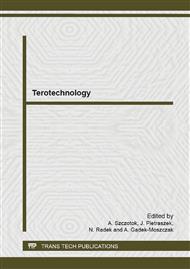[1]
R. Pawlak, Laser processing of elements of Microsystems, Lodz University of Technology 2013, work supported by NCN: 5397/B/T02/2010/39.
Google Scholar
[2]
R. Pawlak, M. Tomczyk, M. Walczak, Modelling in Selected Laser Microtechnologies in Electrical Engineering, Microtherm Proceedings of the Conference Microtechnology and Thermal Problems in Electronics, 2011, Lodz, Poland.
Google Scholar
[3]
R. Pawlak, A. Rosowski, M. Tomczyk, M. Walczak, Simulation Analysis of Thermal State of Conducting Elements with Narrowings Made by Use of Laser Micromachining, Mater. Sci. Eng. B, 176 (2011) 344-351.
DOI: 10.1016/j.mseb.2010.12.001
Google Scholar
[4]
R. Pawlak, M. Tomczyk, M. Walczak, A. Rosowski, Laser Technologies in Micrometer Scale – Realization of Processes with Computer-Aided Modelling, X STL Proceedings, Szczecin-Świnoujście, Poland, 2012 (in Polish).
Google Scholar
[2]
B.N. Chichkov, C. Momma, S. Nolte, F. von Alvensleben, A. Tünnermann, Femtosecond, picosecond and nanosecond laser ablation of solids. Appl. Phys. A 63 (1996) 109-115.
DOI: 10.1007/bf01567637
Google Scholar
[3]
Razvan Stoian , Investigations of the Dynamice of Material Removal in Ultrashort Pulsed Laser Ablation of Dielectrics, Inaugural-Dissertation zur Erlangung des Doktorgrades der FreienUniversität Berlin Fachbereich Physik, October (2000).
Google Scholar
[4]
D. Bäuerle, B. Luk'yanchuk, P. Schwab, X.Z. Wang i E. Arenholtz, Laser ablation: Fundamentals and recent developments, Elsevier Science Publisher B.V., 1992, pp.39-53.
Google Scholar
[5]
Nadezhda M. Bulgakova, Igor M. Bourakov, Phase explosion under ultrashort pulsed laser ablation: modeling with analysis of metastable state of melt, Appl. Surf. Sci. 197–198 (2002) 41-44.
DOI: 10.1016/s0169-4332(02)00300-8
Google Scholar
[6]
A. Miotello, R. Kelly, Laser-induced phase explosion: new physical problems when a condensed phase approaches the thermodynamic critical temperature, Appl. Phys. A69 (1999) 67-73.
DOI: 10.1007/s003399900296
Google Scholar
[7]
N.M. Bulgakova, A.V. Bulgakov, Pulsed laser ablation of solids: transition from normal vaporization to phase explosion, Appl. Phys. A 73 (2001) 199–208.
DOI: 10.1007/s003390000686
Google Scholar
[8]
N.M. Bulgakova, A.V. Bulgakov, L.P. Babich, Energy Balance Of Pulsed Laser Ablation: Thermal Model Revised, Appl. Phys. A 79 (2004) 1323–1326.
DOI: 10.1007/s00339-004-2763-2
Google Scholar
[9]
R. Pawlak, M. Tomczyk, M. Walczak, P. Domagalski, Microstructures of semiconductor and ceramic materials made by ablation of single mode fiber laser – quality and dimensions limit, Microtherm Proceeding of the Conference Microtechnology and Thermal Problems in Electronics, 2013, Lodz, Poland.
DOI: 10.1088/1742-6596/494/1/012015
Google Scholar


